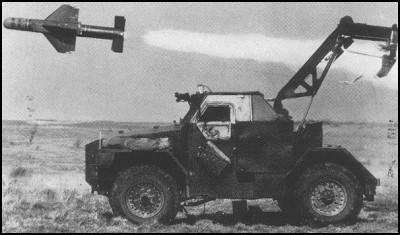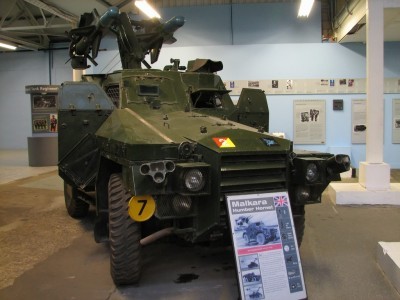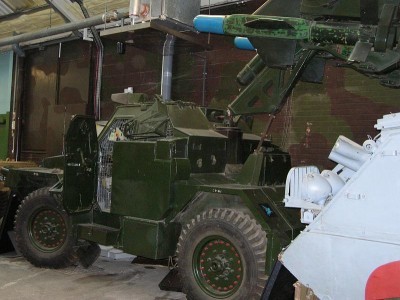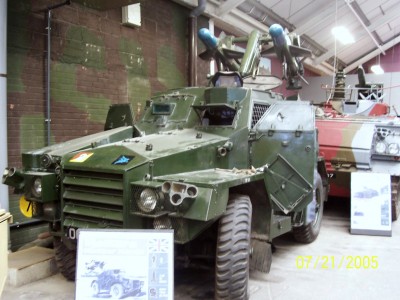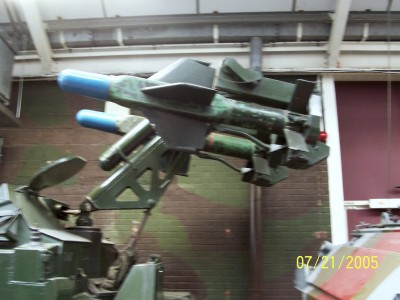| Název: Name: | FV1620 Humber Hornet | FV1620 Humber Hornet |
| Originální název: Original Name: | FV1620 Humber Hornet | |
| Výrobce: Producer: | DD.MM.1958-DD.MM.1961 Wharton Engineers (Elstree) Ltd., Elstree | |
| Období výroby: Production Period: | DD.MM.1958-DD.MM.1961 ? | |
| Vyrobeno kusů: Number of Produced: | 24? | |
| Prototyp vyroben: Prototype Built: | DD.MM.RRRR | |
| Osádka: Crew: | 3 | |
| Technické údaje: Technical Data: | ||
| Bojová hmotnost: Combat Weight: | 5216 kg | 11500 lb |
| Celková délka: Overall Length: | 5639 mm | 18 ft 6 in |
| Celková šířka: Overall Width: | 2032 mm | 6 ft 8 in |
| Celková výška: Overall Height: | 2337 mm | 7 ft 8 in |
| Světlá výška: Ground Clearance: | ? mm | ? |
| Pancéřování: Armour: | - čelo: 12,7 mm - boky, záď, strop a dno: 6,4 mm | front 0.5 in remainder 0.25 in |
| Pohon: Propulsion: | ||
| Typ: Type: | Rolls Royce B60 Mk 5F | Rolls Royce B60 Mk 5F |
| Výkon: Power: | 89.5 kW při 3750 ot/min | 120 bhp at 3750 rpm |
| Převodové ústrojí: Transmission: | mechanická, 5 rychlostí vpřed a 1 vzad | mechanical, 5+1 |
| Výkony: Performance: | ||
| Rychlost na silnici: Road Speed: | 64 km/h | 40 mph |
| Rychlost v terénu: Cross-country Speed: | ? km/h | ? mph |
| Jízdní dosah po silnici: Cruising Range on Road: | 402 km | 250 mi |
| Jízdní dosah v terénu: Cross-country Cruising Range: | ? km | ? mi |
| Překonávání překážek: Obstacles Crossing: | ||
| Svah: Gradient: | ? ° | ? % |
| Boční náklon: Side Slope: | ? ° | ? % |
| Překročivost: Trench Crossing: | ? m | ? |
| Výstupnost: Vertical Obstacle: | ? m | ? |
| Brodivost: Fording Depth: | 0.76 m | 30 in |
| Výzbroj: Armament: | ||
| Hlavní: Main: | 2x protitanková střela Malkara (2 + 2 uložené) | 2 Malkara ATGM (2 + 2 stowed) |
| Vedlejší: Secondary: | - | - |
| Uživatelské státy: User States: | | |
| Poznámka: Note: | - | - |
| Zdroje: Sources: | viz níže | |
FV1620 Humber Hornet
FV 1620 Hornet
co-authored by Jiří Tintěra
The vehicle, with its Malkara anti-tank missiles, was a remarkable British improvisation. The creation of this self-propelled launcher was decided around 23 August 1959, after the Malkara anti-tank guided missile (ATGM) was inducted into the British Army's arsenal. This was notwithstanding the fact that the project's initiator, the Australian Army, had terminated development of the weapon without introducing it into the arsenal.
When the FV1620 was designed, it was envisaged that the vehicle would be airlifted to its destination and dropped by parachute. Within ten minutes of landing, the vehicle was to be ready for combat. The gunner/operator station, who was also the vehicle commander, was located on the left side of the cabin. The operator could control the flight of the missile to the target in two ways, either directly from the vehicle or by means of a profitable control console located within 80 m of the vehicle (other materials speak of 45 m). The missile was guided to the target by commands transmitted over wires that were unwound from coils located on the vehicle.
Because it was a small production run, a modified Humber wheeled armoured personnel carrier chassis was used to manufacture the FV1620, with a launcher (OZ) for two Malkara ATGMs installed at the rear of the vehicle. A storage compartment was placed underneath this device to allow the transport of two more missiles in a disassembled state. It took the trained crew 2 minutes to load them onto the launcher. The missile had a powerful warhead, capable of destroying all tanks of the time by means of a burst effect (Hopkinson effect).
The vehicle, with the battle name Hornet, was in service with the British Army from 1962 in a number of 24. Their use was governed by special regulations, perhaps due to the high purchase price of Malkara missiles. Any firing was only allowed at targets of particular importance. Whereas targets of lesser importance, or less resistant, were destroyed by cheaper anti-tank weapons.
In the 1970s, the FV1620 Hornet tank missile interceptors were replaced by more structurally simple vehicles.
Basic data of the FV1620 Hornet vehicle
- Country of origin: Great Britain
- Prototypes reportedly built by Wharton Engineering
- Finalist was a British firm: the Royal Ordnance Factory in Nottingham
- 24 units produced in total (3 prototypes and 3 batches of 7 units)
- British Army designation: FV1620 Hornet
- in service from 1962
- after 1965 12 were transferred to reserve
- after 1976 all machines were retired from service
- crew: 3 men (commander, driver, radio operator)
- max. 7003 kg (16100 lb av) including platform and parachutes
- unmanned weight: 5824 Mg (12840 lb av)
- curb weight: 5216 Mg (11500 lb av)
- ejection pallet, type: ~20 m)
- deployable parachute, number and type: 1x 21-ft (approx. parachute diameter: 6.4 m)
Dimensions
- length: 5639 mm (18 ft 6 in)
- width: 2032 mm (6 ft 8 in)
- height on the move: 2337 mm (7 ft 8 in)
- height of the intentional axis of the vehicle guidance device: 2108 mm (6 ft 11 in)
- max. height with weapon: 3416 mm (11 ft 2.5 in)
Armor
- nose: 12.7 mm (0.5 in)
- sides, rear, ceiling and bottom: 6.4 mm (0.25 in)
Chassis
- type: chassis Humber FV1611 (chassis modified)
- layout: 4x4
- wheelbase: ?
- wheelbase: ?
- self-supporting tyre size: 11.00x20
Powertrain
- type: Rolls Royce B60 Mk. 5F
- capacity: 4.2 dm3
- power: 89.5 kW (120 HP SAE) at 3750 rpm.
- arrangement: 6 cylinders in series, water-cooled, gasoline engine
Transmission
- design: manual shift
- arrangement: 5 forward and 1 reverse speed
Performance
- max. 40 mph (~64 km/h)
- range: 250 miles (~400 km)
- ford: 2 ft 6 in (~0.76 m)
- vehicle was not capable of crossing ditches
Weaponry
- type, name: Malkara heavy anti-tank missile
- number of missiles carried: 4 pieces (2 in launcher and 2 in storage compartment)
A few FV1620 vehicles currently serve as exhibits
05BK02 - probably in private collection, attends many reunions
06BK66 - Tank Museum Bovington, formerly at Museum of Army Transport, V. UK
11BK42 - Musee des Blindes, Saumur, France
NFF 672 - probably in private collection, attends many reunions
1x wreck of third prototype in private collection, Australia
Note
The word Malkara, read: Melkere, means in one dialect of Australian bushwhacking: a wooden defensive shield.
The last user of the FV1620 Hornet was the 16th Independent Parachute Brigade.
The English system of measurements was converted from Svatopluk Cernoch's Mechanical Technical Manual, SNTL, Prague 1959, ISBN not available
Technical data was prepared according to: ČSN 011300, SI Tables, Prague 1977
Source
Milan Šesták a kolektiv: Rozpoznávání raket - letadel - tank, Naše vojsko, Prague 1964, ISBN nemá
Vjačjeslav Špakovskij: Aeromobil′nyj anti-tank, Tankomastjer 2003/06/43-47, ISSN 1728-9211
Philip Trewhitt: Obrněná bojová vozidla, Svojtka Publishing House, Prague 2000, ISBN 80-7237-234-3
Chris Bishop: Modern Military Weapons - Large Encyclopedia, Svojtka Publishing House, Prague 2004, ISBN 80-7237-863-5
Internet
http://armygear.org/?Items:Armour_-_Page_1
http://cs.wikipedia.org/wiki/%C5%A0t%C3%ADt
http://en.wikipedia.org/wiki/Humber_Hornet
http://i17.ebayimg.com/05/i/000/c3/30/b2ea_1.JPG
kr.blog.yahoo.com
members.fortunecity.com
http://middle-watch.com/seacat.htm
http://otvaga2004.narod.ru/publ_w2/hornet.htm
www.arrse.co.uk
www.arrse.co.uk
www.defence.gov.au
www.defence.gov.au
http://www.fleetdata.co.uk/
www.grandpapencil.net
http://www.mafva.net/other%20pages/VRNARMY.doc
www.militaryfactory.com
http://www.rofnottingham.co.uk/07_process_02.htm
www.specialistauctions.com
http://www.warwheels.net/ACJ30.html
http://www.warwheels.net/HumberHORNETindex.html
www.warwheels.net
www.jedsite.info
co-authored by Jiří Tintěra
The vehicle, with its Malkara anti-tank missiles, was a remarkable British improvisation. The creation of this self-propelled launcher was decided around 23 August 1959, after the Malkara anti-tank guided missile (ATGM) was inducted into the British Army's arsenal. This was notwithstanding the fact that the project's initiator, the Australian Army, had terminated development of the weapon without introducing it into the arsenal.
When the FV1620 was designed, it was envisaged that the vehicle would be airlifted to its destination and dropped by parachute. Within ten minutes of landing, the vehicle was to be ready for combat. The gunner/operator station, who was also the vehicle commander, was located on the left side of the cabin. The operator could control the flight of the missile to the target in two ways, either directly from the vehicle or by means of a profitable control console located within 80 m of the vehicle (other materials speak of 45 m). The missile was guided to the target by commands transmitted over wires that were unwound from coils located on the vehicle.
Because it was a small production run, a modified Humber wheeled armoured personnel carrier chassis was used to manufacture the FV1620, with a launcher (OZ) for two Malkara ATGMs installed at the rear of the vehicle. A storage compartment was placed underneath this device to allow the transport of two more missiles in a disassembled state. It took the trained crew 2 minutes to load them onto the launcher. The missile had a powerful warhead, capable of destroying all tanks of the time by means of a burst effect (Hopkinson effect).
The vehicle, with the battle name Hornet, was in service with the British Army from 1962 in a number of 24. Their use was governed by special regulations, perhaps due to the high purchase price of Malkara missiles. Any firing was only allowed at targets of particular importance. Whereas targets of lesser importance, or less resistant, were destroyed by cheaper anti-tank weapons.
In the 1970s, the FV1620 Hornet tank missile interceptors were replaced by more structurally simple vehicles.
Basic data of the FV1620 Hornet vehicle
- Country of origin: Great Britain
- Prototypes reportedly built by Wharton Engineering
- Finalist was a British firm: the Royal Ordnance Factory in Nottingham
- 24 units produced in total (3 prototypes and 3 batches of 7 units)
- British Army designation: FV1620 Hornet
- in service from 1962
- after 1965 12 were transferred to reserve
- after 1976 all machines were retired from service
- crew: 3 men (commander, driver, radio operator)
- max. 7003 kg (16100 lb av) including platform and parachutes
- unmanned weight: 5824 Mg (12840 lb av)
- curb weight: 5216 Mg (11500 lb av)
- ejection pallet, type: ~20 m)
- deployable parachute, number and type: 1x 21-ft (approx. parachute diameter: 6.4 m)
Dimensions
- length: 5639 mm (18 ft 6 in)
- width: 2032 mm (6 ft 8 in)
- height on the move: 2337 mm (7 ft 8 in)
- height of the intentional axis of the vehicle guidance device: 2108 mm (6 ft 11 in)
- max. height with weapon: 3416 mm (11 ft 2.5 in)
Armor
- nose: 12.7 mm (0.5 in)
- sides, rear, ceiling and bottom: 6.4 mm (0.25 in)
Chassis
- type: chassis Humber FV1611 (chassis modified)
- layout: 4x4
- wheelbase: ?
- wheelbase: ?
- self-supporting tyre size: 11.00x20
Powertrain
- type: Rolls Royce B60 Mk. 5F
- capacity: 4.2 dm3
- power: 89.5 kW (120 HP SAE) at 3750 rpm.
- arrangement: 6 cylinders in series, water-cooled, gasoline engine
Transmission
- design: manual shift
- arrangement: 5 forward and 1 reverse speed
Performance
- max. 40 mph (~64 km/h)
- range: 250 miles (~400 km)
- ford: 2 ft 6 in (~0.76 m)
- vehicle was not capable of crossing ditches
Weaponry
- type, name: Malkara heavy anti-tank missile
- number of missiles carried: 4 pieces (2 in launcher and 2 in storage compartment)
A few FV1620 vehicles currently serve as exhibits
05BK02 - probably in private collection, attends many reunions
06BK66 - Tank Museum Bovington, formerly at Museum of Army Transport, V. UK
11BK42 - Musee des Blindes, Saumur, France
NFF 672 - probably in private collection, attends many reunions
1x wreck of third prototype in private collection, Australia
Note
The word Malkara, read: Melkere, means in one dialect of Australian bushwhacking: a wooden defensive shield.
The last user of the FV1620 Hornet was the 16th Independent Parachute Brigade.
The English system of measurements was converted from Svatopluk Cernoch's Mechanical Technical Manual, SNTL, Prague 1959, ISBN not available
Technical data was prepared according to: ČSN 011300, SI Tables, Prague 1977
Source
Milan Šesták a kolektiv: Rozpoznávání raket - letadel - tank, Naše vojsko, Prague 1964, ISBN nemá
Vjačjeslav Špakovskij: Aeromobil′nyj anti-tank, Tankomastjer 2003/06/43-47, ISSN 1728-9211
Philip Trewhitt: Obrněná bojová vozidla, Svojtka Publishing House, Prague 2000, ISBN 80-7237-234-3
Chris Bishop: Modern Military Weapons - Large Encyclopedia, Svojtka Publishing House, Prague 2004, ISBN 80-7237-863-5
Internet
http://armygear.org/?Items:Armour_-_Page_1
http://cs.wikipedia.org/wiki/%C5%A0t%C3%ADt
http://en.wikipedia.org/wiki/Humber_Hornet
http://i17.ebayimg.com/05/i/000/c3/30/b2ea_1.JPG
kr.blog.yahoo.com
members.fortunecity.com
http://middle-watch.com/seacat.htm
http://otvaga2004.narod.ru/publ_w2/hornet.htm
www.arrse.co.uk
www.arrse.co.uk
www.defence.gov.au
www.defence.gov.au
http://www.fleetdata.co.uk/
www.grandpapencil.net
http://www.mafva.net/other%20pages/VRNARMY.doc
www.militaryfactory.com
http://www.rofnottingham.co.uk/07_process_02.htm
www.specialistauctions.com
http://www.warwheels.net/ACJ30.html
http://www.warwheels.net/HumberHORNETindex.html
www.warwheels.net
| Period | - |
| Type | - |
| Camouflage | - |
| Country | - |
| Production No. | - |
| Poznávací značka / evidenční číslo | - |
| Tactical marking | - |
| Name | - |
| Unit | - |
| Date (DD.MM.RRRR) | - |
| Author | - |
| Print size / 300 DPI | - |
| Published with authors permit | - |
| Author Website | - |
www.jedsite.info
| Period | - |
| Type | - |
| Camouflage | - |
| Country | - |
| Production No. | - |
| Poznávací značka / evidenční číslo | - |
| Tactical marking | - |
| Name | - |
| Unit | - |
| Date (DD.MM.RRRR) | - |
| Author | - |
| Print size / 300 DPI | - |
| Published with authors permit | - |
| Author Website | - |
| Period | - |
| Type | - |
| Camouflage | - |
| Country | - |
| Production No. | - |
| Poznávací značka / evidenční číslo | - |
| Tactical marking | - |
| Name | - |
| Unit | - |
| Date (DD.MM.RRRR) | - |
| Author | - |
| Print size / 300 DPI | - |
| Published with authors permit | - |
| Author Website | - |
| Period | - |
| Type | - |
| Camouflage | - |
| Country | - |
| Production No. | - |
| Poznávací značka / evidenční číslo | - |
| Tactical marking | - |
| Name | - |
| Unit | - |
| Date (DD.MM.RRRR) | - |
| Author | - |
| Print size / 300 DPI | - |
| Published with authors permit | - |
| Author Website | - |
| Period | - |
| Type | - |
| Camouflage | - |
| Country | - |
| Production No. | - |
| Poznávací značka / evidenční číslo | - |
| Tactical marking | - |
| Name | - |
| Unit | - |
| Date (DD.MM.RRRR) | - |
| Author | - |
| Print size / 300 DPI | - |
| Published with authors permit | - |
| Author Website | - |
Reklama
This post has not been translated to English yet. Please use the TRANSLATE button above to see machine translation of this post.
(©Radek Havelka)
This post has not been translated to English yet. Please use the TRANSLATE button above to see machine translation of this post.
| Period | - |
| Type | - |
| Camouflage | - |
| Country | - |
| Production No. | - |
| Poznávací značka / evidenční číslo | - |
| Tactical marking | - |
| Name | - |
| Unit | - |
| Date (DD.MM.RRRR) | DD.MM.RRRR |
| Author | - |
| Print size / 300 DPI | - |
| Published with authors permit | - |
| Author Website | - |
| Period | - |
| Type | - |
| Camouflage | - |
| Country | - |
| Production No. | - |
| Poznávací značka / evidenční číslo | - |
| Tactical marking | - |
| Name | - |
| Unit | - |
| Date (DD.MM.RRRR) | DD.MM.RRRR |
| Author | - |
| Print size / 300 DPI | - |
| Published with authors permit | - |
| Author Website | - |
Join us
We believe that there are people with different interests and experiences who could contribute their knowledge and ideas. If you love military history and have experience in historical research, writing articles, editing text, moderating, creating images, graphics or videos, or simply have a desire to contribute to our unique system, you can join us and help us create content that will be interesting and beneficial to other readers.
Find out more